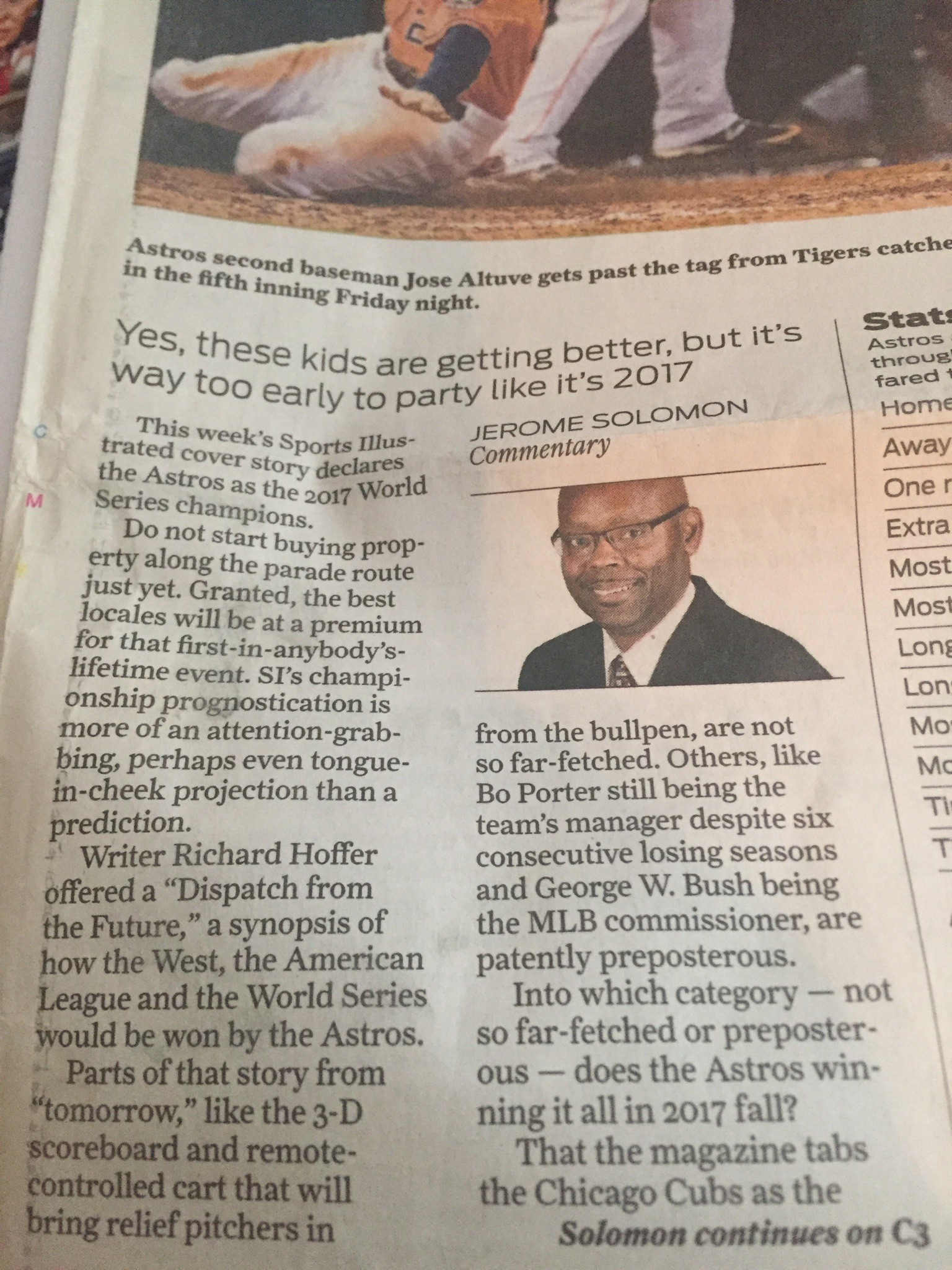I remember the feeling of awe walking to our seats at the Astrodome. My dad took me to my first game when I was eight years old.
The Astros were playing the Cubs. Astros first-baseman Glenn Davis hit a 427-foot homerun to dead center. As Davis rounded the bases, the electronic board displayed a rocket show, gun-slinging cowboys, and snorting bulls. It was like watching a giant Atari game.
That was 30 years ago. Some things from my childhood I can remember in vivid detail.
Slumpbusters
We were Cubs fans when I was a kid. Since we got WGN at home, Harry Caray’s voice could be heard throughout our house in the afternoons. Our summer vacations to Houston were planned for when the Cubs were in town.
Mark Grace was my favorite player. Later in life, when I heard him talk about “slumpbusters,” I was appalled. Just kidding, I liked him even more. Not because I would personally “hop on a grenade” to end a slump when I played, but because I appreciate candor in all its forms. Grace’s comment reminded me of teammates who thought a beached whale was the “bunt-single” they desperately needed to end their slump.
I believe it was honest Abe Lincoln who said, “Whether you call ’em ‘beached whales’ or ‘cleat-chasers,’ one thing you can’t call them is ungrateful. Because if it’s true that men regret casual romps they didn’t have, and women regret ones they did have, cleat-chasers serve as an exception to that rule.”
The Day I Became an Astros Fan
I became an Astros fan when I moved to Houston. But it didn’t happen instantly. I needed to be sold.
On August 6, 1994, while my dad was pumping gas in Baytown (near Houston), I went inside to pay. The guy in front of me in line was built like he was somebody. He had calves the size of softballs—his left one had a large tattoo. So I peaked around his shoulder to get a look at his face. He looked down at me as if to say, “I know you know who I am, kid.”
I smiled and whispered, “What’s your name?”
He whispered back, “Ralph.”
I said, “Ralph, I want to do what you do some day.”
He cracked a smile and said, “It’s fun. Except for what we’re going through right now (baseball strike).”
I said, “Man I know, I hope you guys start playing again soon.”
He said, “Me too.”
When I got in my dad’s car, I said, “Dad, did you see that big guy who came out before me?”
He said, “Yeah, who was that?”
I said, “That was Ken Caminiti.”
My dad said, “Aw c’mon!…he told me I had a good kid.”
I was sold.
Astros (2005 – 2015)
The middle of last decade was a good time to be an Astros fan. The Killer B’s—Jeff Bagwell, Lance Berkman, and Craig Biggio—combined with a pitching staff loaded with Roy Oswalt, Roger Clemens, and Andy Pettitte, to make the World Series in 2005, but they were swept by the White Sox.
In 2010, the Astros finished 10 or more games under .500 for the third season out of four. At that time, Baseball America ranked Houston’s farm system as the game’s worst.
In 2011, the Astros were up for sale, while finishing with a record of 56-106. To say there were half-empty seats would be too generous. One could only hope they had a plan to turn things around.
They did. Astros new owner Jim Crane hired away St. Louis Cardinals’ Scouting Director, Jeff Lunhow, and made him GM. The Astros had the number one overall pick in the draft from 2012-2014, then the second overall pick in 2015.
Astroball is Data-Driven Baseball
When Lunhow arrived in Houston, half of Major League Baseball organizations were using Moneyball strategies, so there was no differentiation in employing them. For a competitive advantage, teams had to find new ways to exploit data.
For example, the Astros acquired a 26-year old named Collin McHugh, despite appearing to be the league’s worst pitcher. He had an ERA of 8.94 in 15 outings in 2012 and 2013. But the Astros new analytics team noticed McHugh had a curveball that revolved over 2,000 times per minute, which put him in rarefied company with Felix Hernandez and Adam Wainwright. The Astros front office thought McHugh could be successful if he just threw more curveballs.
The Astros developed spray charts on every hitter, on every count, versus every pitch thrown by every pitcher in the league, as well as the probabilistically optimal way to position the defense. They deployed extreme defensive shifts, often against a pitcher’s wishes.
When managers were interviewed, Lunhow asked each of ten candidates if they would be OK with him sending down the lineup every day. Those who said that was fine gave the wrong answer. Lunhow wanted to equip the manager with analytics and resources to be successful. But only a manager would know who was fatigued, wasn’t feeling well or hadn’t slept the night before.
Growth Mindset to 2017
The Astros front office was transparent about their plans. They talked about growth mindset, and wanted fans to trust the process. They believed maintaining a .500 record while building a Championship-caliber team, like so many other clubs before them, was a mistake. Instead, they believed if the Astros fan-base could suffer through some of the worst seasons in franchise history, a perennial contender would follow.
I had faith enough that I saved a Houston Chronicle article from June 29, 2014. I thought it might one day pair well with a glass of champagne.
In the article, Jerome Solomon gave grades to general manager Jeff Luhnow (C for creativity) and the franchise (D for disappointment). He wrote that Sports Illustrated’s prediction that the Astros would win the 2017 World Series was fantasy.
“Do not start buying property along the parade route…for that first-in-anybody’s-lifetime event. SI’s prognostication is more of an attention-grabbing, perhaps even tongue-in-cheek projection than prediction.” – Jerome Solomon, referring to SI prediction that the Astros would win the World Series in 2017

Solomon’s article didn’t age well—SI’s prediction came true—the Houston Astros were 2017 World Series Champions. George Springer, who donned the cover of that now-famed SI issue, was named World Series MVP.
2018 ALCS (Astros vs. Red Sox)
I took my dad to Game 3 of the American League Championship Series on Tuesday. We were celebrating his 65th birthday. I asked him if he felt “65,” as we walked to the stadium. He said, “No. But some things I forget, that I don’t think I would have forgotten years ago.”
As we crossed the street, we started talking baseball. I asked if he knew where Alex Bregman was taken in the draft.
He said, “Second overall pick.”
I said, “Who was the top pick that year?”
He said, “Oh no, I don’t remember.”
As we walked into the stadium, Dad said, “Dansby Swanson.”
I said, “What?”
He said, “Dansby Swanson. That’s who was the first overall pick the year Bregman went second.”
I was impressed, but told him there isn’t a need to remember things like that anymore. I said it would take ten seconds to pull my phone out and get the answer to a question like that. He disagreed, said he wanted to remember that sort of thing because it was good for him—keeps his mind sharp.
Typical of my dad, he made friends with a Red Sox fan sitting next to him. I heard him tell the guy that the yellow line in left-centerfield [at Minute Maid Park] wasn’t always there. He then explained where the ball needed to be hit years ago to be considered a homerun.
I nudged my dad and said, “I don’t think that’s right [placement of yellow line].” I pulled out my phone and “google-imaged” an old picture of Enron Field.
I was wrong. He was right.
The next morning I got a text saying, “Thanks again. Had a great time.” But there was no need to thank me—I was just returning the favor from 30 years ago. At least, I think it was 30 years ago. I’ll ask him, to be sure.




Very good
Thank you!
Thanks for the memories, old and new!
Dear “Old” Dad
…with a mind like a steel trap!
Loved reading this Brad! So many great points. And your dad reminds me a bit of mine ❤️.
Thank you, Jenny. We’re lucky!